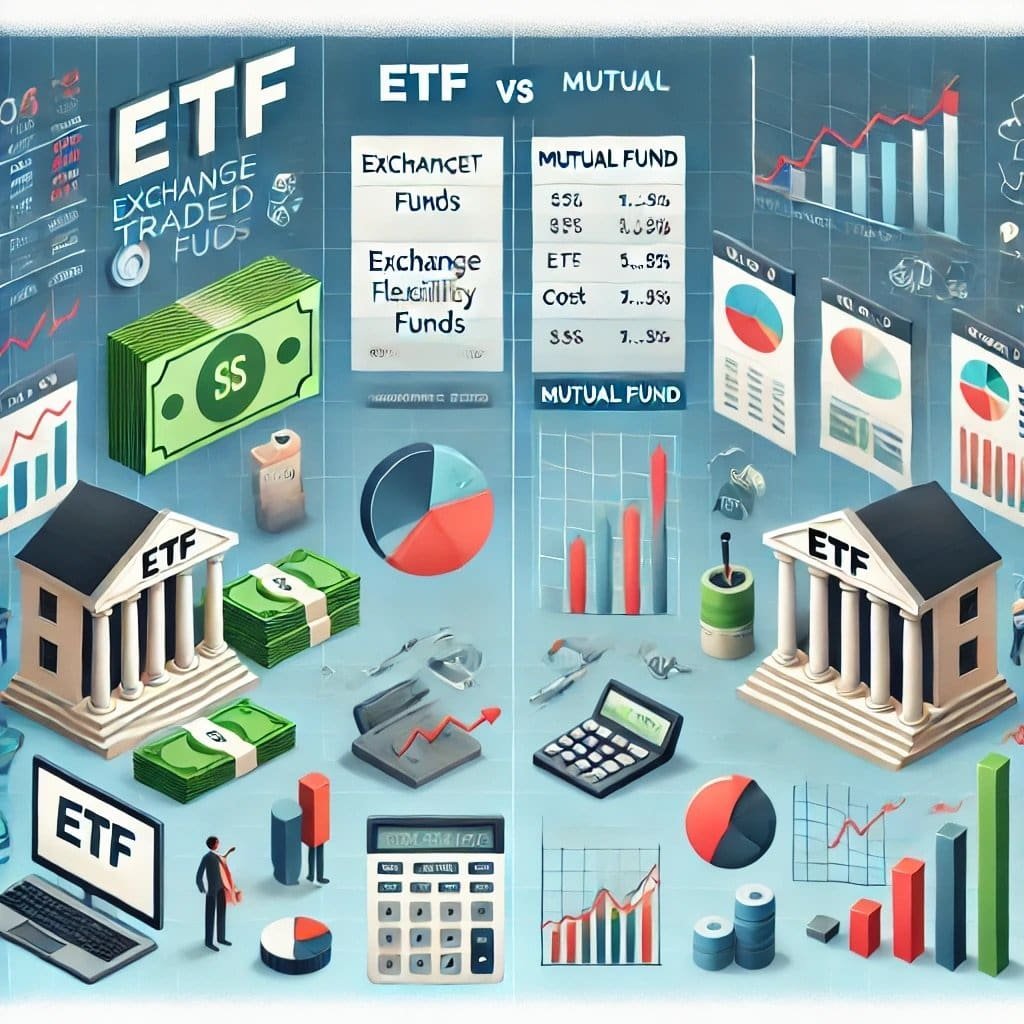Exchange-Traded Funds (ETFs) and mutual funds are two popular investment vehicles that allow individuals to diversify their portfolios by investing in a basket of securities. While they share similarities, such as providing access to multiple assets in a single fund, there are key differences that make each suitable for different types of investors. Understanding these distinctions can help you choose the best option for your financial goals.
What are ETFs?
ETFs, or Exchange-Traded Funds, are investment funds that hold a collection of assets like stocks, bonds, or commodities. ETFs are traded on stock exchanges, just like individual stocks, allowing investors to buy and sell shares throughout the trading day.
Key Features of ETFs:
• Trading Flexibility: ETFs can be bought and sold on an exchange during market hours, meaning their price fluctuates throughout the day based on supply and demand.
• Lower Costs: ETFs generally have lower expense ratios compared to mutual funds, as they are often passively managed (tracking an index like the S&P 500).
• Transparency: ETF holdings are disclosed daily, so investors know exactly what they are investing in.
• Tax Efficiency: Due to their structure, ETFs tend to be more tax-efficient than mutual funds, which can help investors avoid capital gains taxes until they sell their shares.
What are Mutual Funds?
Mutual funds pool money from multiple investors to invest in a diversified portfolio of stocks, bonds, or other securities. Unlike ETFs, mutual fund shares are not traded on exchanges. Instead, they are bought and sold directly through the fund at the end of the trading day at the fund’s Net Asset Value (NAV).
Key Features of Mutual Funds:
• Professional Management: Mutual funds are typically actively managed by a portfolio manager, who makes decisions about buying and selling securities based on research and analysis.
• End-of-Day Trading: Mutual fund transactions are executed at the end of the trading day, meaning all buys and sells happen at the NAV, which is calculated after market close.
• Higher Fees: Actively managed mutual funds often come with higher fees, including management fees and sometimes sales loads, to cover the costs of active management.
• Minimum Investment: Many mutual funds have a minimum investment requirement, which can range from a few hundred to several thousand dollars.
Key Differences Between ETFs and Mutual Funds
Feature ETFs Mutual Funds
Trading Traded on an exchange during market hours Bought and sold at the end of the day at NAV
Management Style Usually passively managed (track an index) Often actively managed
Expense Ratios Typically lower due to passive management Higher fees due to active management
Tax Efficiency More tax-efficient Less tax-efficient due to capital gains distribution
Investment Minimum No minimum (can buy a single share) Often have a minimum investment requirement
Transparency Daily disclosure of holdings Holdings are disclosed quarterly
ETFs vs. Mutual Funds: Which Should You Choose?
1. Flexibility and Liquidity:
• Choose ETFs if you want the flexibility to trade throughout the day. ETFs allow you to take advantage of intra-day price movements and adjust your portfolio as market conditions change.
• Choose Mutual Funds if you prefer not to worry about daily market fluctuations and are comfortable with end-of-day pricing. Mutual funds are ideal for investors with a long-term focus who don’t need immediate liquidity.
2. Cost Efficiency:
• Choose ETFs if keeping costs low is a priority. ETFs typically have lower expense ratios, especially if you opt for passive index-tracking ETFs. Since there are no minimum investment requirements, you can start small and avoid high fees.
• Choose Mutual Funds if you prefer active management and are willing to pay higher fees for a portfolio manager’s expertise. If you’re investing in a specific strategy or asset class, an actively managed mutual fund may offer more tailored investment choices.
3. Tax Considerations:
• Choose ETFs if tax efficiency is important. Due to the unique structure of ETFs, they can help you avoid triggering capital gains taxes until you decide to sell your shares.
• Choose Mutual Funds if you’re less concerned about taxes and are focused on a specific investment strategy that may only be available through mutual funds.
4. Long-Term vs. Short-Term Investing:
• Choose ETFs if you’re looking for a low-cost, long-term investment in a broad index or sector. ETFs are ideal for passive investors who want exposure to specific markets or industries with minimal fees.
• Choose Mutual Funds if you prefer a more hands-on approach to long-term investing, with the potential for higher returns through active management.
The Role of Index Funds in ETFs and Mutual Funds
It’s important to note that both ETFs and mutual funds can be structured as index funds. Index funds aim to replicate the performance of a specific market index (e.g., the S&P 500). These funds are passively managed and tend to have lower fees, making them attractive options for cost-conscious investors.
• Index ETFs: These ETFs track an index and offer all the benefits of ETFs, such as intra-day trading and lower fees.
• Index Mutual Funds: These mutual funds also track an index, but they are traded at the end of the day like other mutual funds. They typically have lower fees compared to actively managed mutual funds but lack the trading flexibility of ETFs.
Conclusion
ETFs and mutual funds both offer unique advantages depending on your investment style and financial goals. ETFs are ideal for investors seeking low-cost, flexible options that can be traded like stocks, while mutual funds are better suited for those who prefer professional management and are focused on long-term goals. By understanding the key differences between the two, you can choose the investment vehicle that best aligns with your portfolio strategy and risk tolerance.


